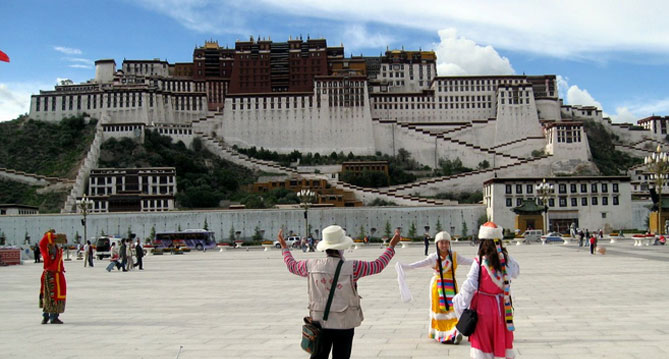Tibet is certainly one of the place you just have to visit once in a lifetime. After centuries of virtual isolation Tibet is cautiously opening up to the western world. Tibet is an awesome experience, but it is not for the faint-hearted. Kathmandu provides the gate way in to Tibet. There is a direct flight to Lhasa but you can also drive from Kathmandu. There are trekking routes from Humla in Nepal to Simikote to Mount Kailash in Tibet as well. Best time to visit Tibet is from May to September.
Language: - The Tibetan language is generally classified as a Tibeto-Burman language of the Sino-Tibetan language family although the boundaries between 'Tibetan' and certain other Himalayan languages can be unclear.
History:- History of Tibet is linked closely to Buddhism as this religion played a major role in development of Tibetan, Mongol and Manchu cultures and that the historians were Buddhist monk. Accordingly, there is also a close link with Mongol and Chinese empires. Earlier Tibetan historical text indicates Zhang Zhung as the people who settled in what is now Guge in western Tibet. Mythology of Tibet names Nyatri Tsenpo as the first king of Tibet although dates differ from 125BC to 400BC depending on different text. Zhang Zhung was annexed by Nimri Songtsen in the 7th century who united parts of the Yarlung River Valley and founded the Tibetan Empire. From 7th to 11th century Tibet was ruled by number of emperors of the Yarlung Dynasty. During 9th century the Tibetan empire extended all the way south to part of Bengal and far north to Mongolia but the empire started to fragment with rebellions and rise of regional warlords. By 11th century the entire Tibetan empire collapsed and central rule was largely nonexistent. From 1236 Shakya lamas ruled Tibet under the patronage of powerful Mongol empire of Ghangis and Kublai Khans. In mid 14th century, after another termoil saw the rise of Phagmodru family who ruled Tibet as an independant country which lasted nearly 400 years. Rule by the Dalai Lama lineage started with Lobsang Gyatso the Great Fifth Dailai Lama from 1617 to 1682. He is credited for uniting most of Tibetan heartland under the control of the Gelung school of Tibetan Buddhism (Yellow Hat Sect). He also built the Potala Palace in Lhasa move the centre of government there from Drepung. From the period of the 6th Dalai Lama, Tibet came under control of Machurian Qing Dynasty and this continued on and off until begining of 19th century. Authority of Qing Dynasty gradually weakened to the point being just symbolic. After the fall of Qing Dynasty in 1912, Tibet again enjoyed de facto independence until 1950s when China again started asserting their control. In 1965 Tibet was renamed as Tibet Autonomous Region (TAR) of China. Current 14th Dalai Lama fled to India in 1959 and established the Tibetan Government in Exile in the mountainous region of Dharamsala.
Geography: - Tibet lies between the core areas of the ancient civilisations of China and of India. Extensive mountain ranges to east of the Tibetan Plateau marks the eastern border with China and the towering Himalayas of Nepal and India form a barrier to Tibet from India and Nepal in the south. Most modern geographical sources consider Tibet to be located in East Asia while some (mostly European and American sources) have regarded Tibet as part of Central Asia. Today's maps of the West show a trend toward considering all of modern China, including Tibet, to be part of East Asia. Tibet is west of China proper, and within China. Tibet is regarded as part of Xibu a term usually translated by Chinese media as "the Western section", meaning "Western China".
Culture & Religion: - Religion and spirituality is extremely important to the Tibetans and has influence over all aspects of their lives and is deeply ingrained into their cultural heritage. Bon is the ancient traditional religion of Tibet, but following the introduction of Tantric Buddhism into Tibet by Padmasambhava this became eclipsed by Tibetan Buddhism, a distinctive form of Vajrayana. Tibetan Buddhism is practiced not only in Tibet but also in Nepal, Mongolia, parts of northern India, the Buryat Republic, the Tuva Republic, and in the Republic of Kalmykia and some other areas in China.
Airports:
Lhasa's Gongkar Airport is located 95 kilometres southwest of the city. A taxi will cost approximately Y200 for the long journey.
Telephone:
The international dialling code for China (Tibet) is +85.
You can try to make international calls with mixed results. Your hotel will also mail letters for you.
Electricity:
Tibet's electricity is 220 volts. Throughout Tibet electricity is subject to failure on occasions, so a torch is an essential piece of equipment for your tour.
Food:
Most hotels provide reasonable selection of western food in their manu. One Tibetan foods that might appeal to you is momos, which are small dumplings filled with meat or vegetables and is fried or steamed. The basic Tibetan meal is tsampa, a dough made with roasted barley flour and yak butter mixed with water, tea or beer. You will also come across plenty of yak products, be it dried, stewed, cheesed or in noodle soups.
Economy: - The Tibetan economy is dominated by subsistence agriculture. Due to limited arable land, the primary occupation of the Tibetan Plateau is raising livestock, such as sheep, cattle, goats, camels, yaks, dzo, and horses. The main crops grown are barley, wheat, buckwheat, rye, potatoes, and assorted fruits and vegetables. As a result of being subsistence agricultural society Tibet is ranked the lowest among China’s 31 provinces, on the Human Development Index according to UN Development Programme data.






